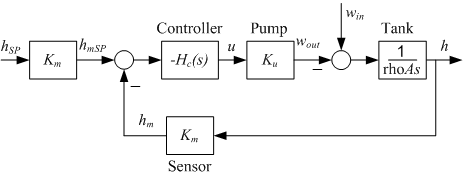LIQUID LEVEL CONTROL OF BUFFER TANK
- Picture of the frontpanel of the simulator
- What is needed to run the the simulator? Read to get most recent information!
- Tips for using the simulator.
- The simulator: buffer_tank.exe (click to download). The simulator runs immediately after the download by clicking Open in the download window. Alternatively, you can first save a copy of the exe-file on any directory (folder) on your PC and then run the exe-file, which starts the simulator.
Description of the simulated system
The system which is simulated is a level controlled liquid tank with inlet and outlet, see the front panel of the simulator. A methematical model of the tank can be derived from a mass balance:
(1) rho*Adh/dt = win - wout
where wout = Kuu where u is the control signalet to the pump (being calulated by the controller).
Figure 1 shows a block diagram of the tank model including the level control system.

Figure 1
Motivation
The tank may represent a unit process in a process string. The purpose of the tank is to attenuate inlet flow variations, while keeping the tank level sufficiently close to the level setpoint.
Theory
Tuning a PI controller for a level control system is described in the text-book PID Control. Copy of the book section of interest.
Task
- What is the transfer function from w_in
to w_out?
Explain from the block diagram in Figure 1 (no detailed calculations are required) that the transfer function from win to wout is the same as the the tracking transfer function, T(s), of the level control system. T(s) is the transfer function from the hmSP to hm in the block diagram.
- Tuning the level controller:
Run the simulator.
- Find proper values of a PI controller from the specification that a frequency component of 0.04Hz in win is attenuated by a factor of 5 through the tank, i.e. wout has amplitude equal to 1/5 of the amplituden of win at this frequency. (Tip: It may be necessary with some trial-and-error in finding f0, using the Bode diagram in the simulator. Note: The PI settings that you obtain as functiond of zeta and f0, must be written into the parameter field of the controller.)
- Verify using simulation that the specification is obtained.
- Is the flow attenuaton better or worse if the frequency of the inlet flow is decreased? Give the answer from the Bode diagram, and verify by running a simulation.
- What is the benefit of using a PI
controller in stead of a P controller?
- Give a reason why PI control is better than P control for the buffer tank. Demonstrate using simulation.
- Why at all is it necessary to have a level control system for the buffer tank? Why not just use a fixed control dignal to the pump? Demonstrate using simulation.
Updated October 2, 2004. Developed by Finn Haugen. E-mail: finn@techteach.no.
